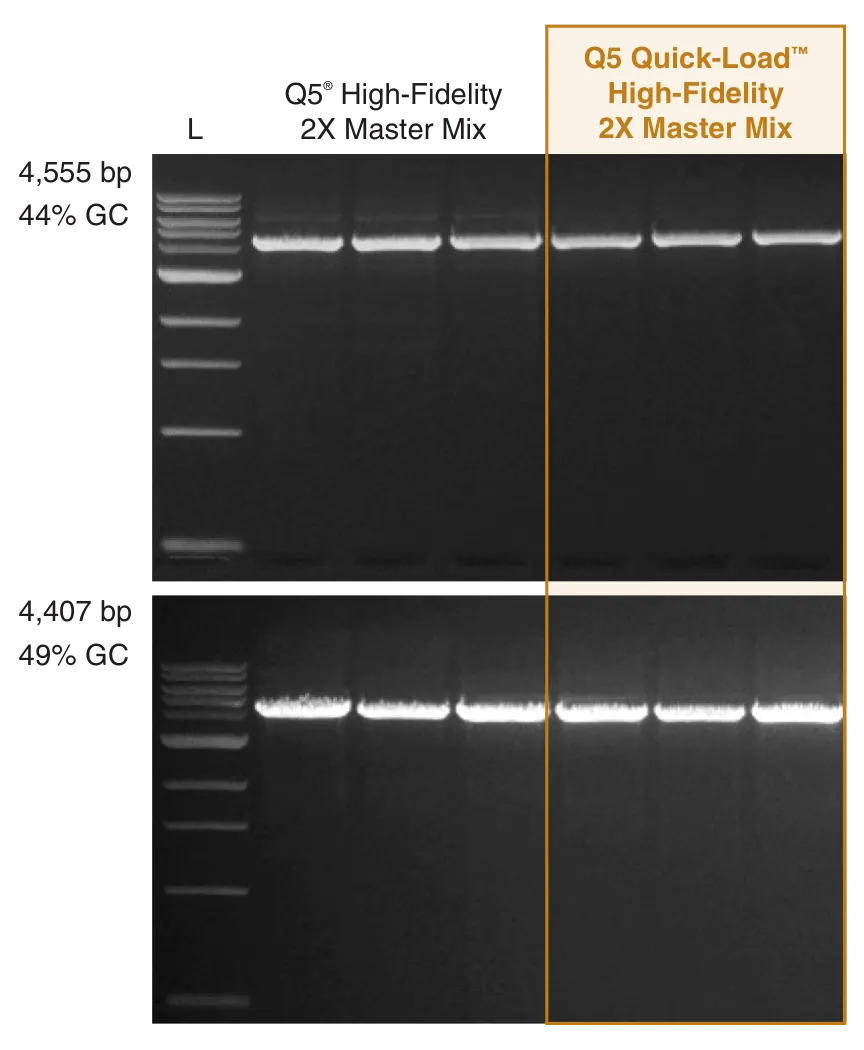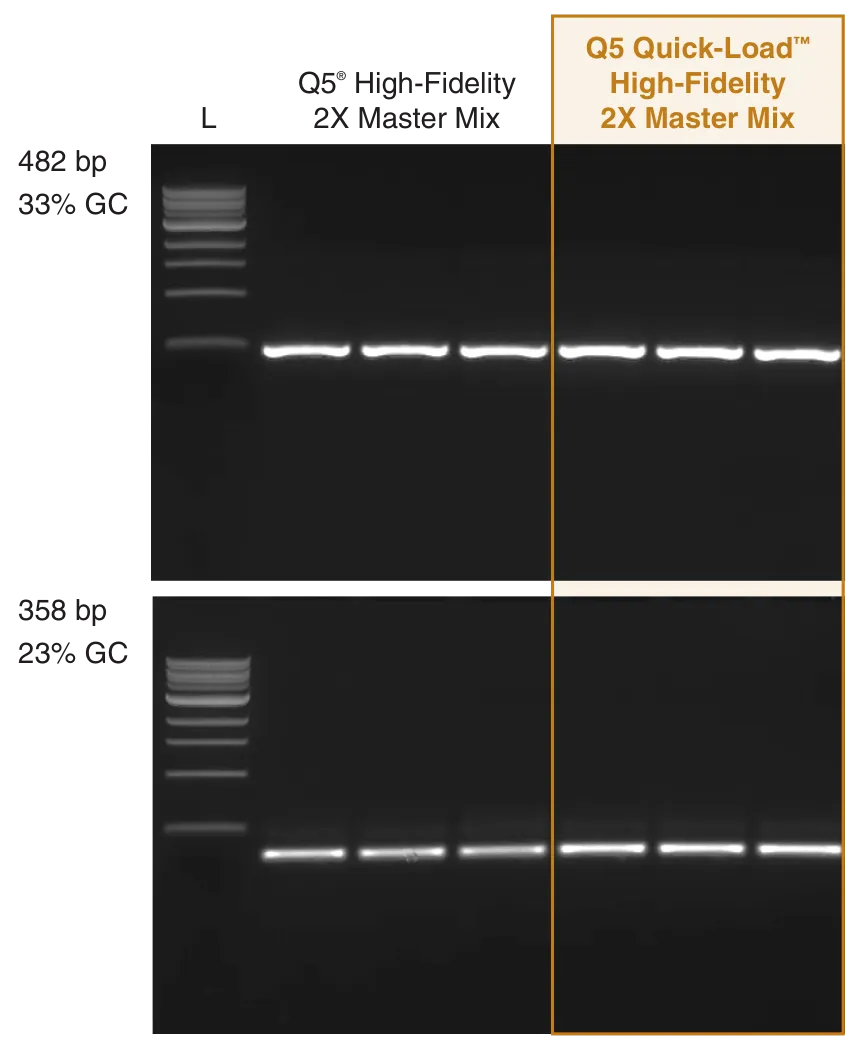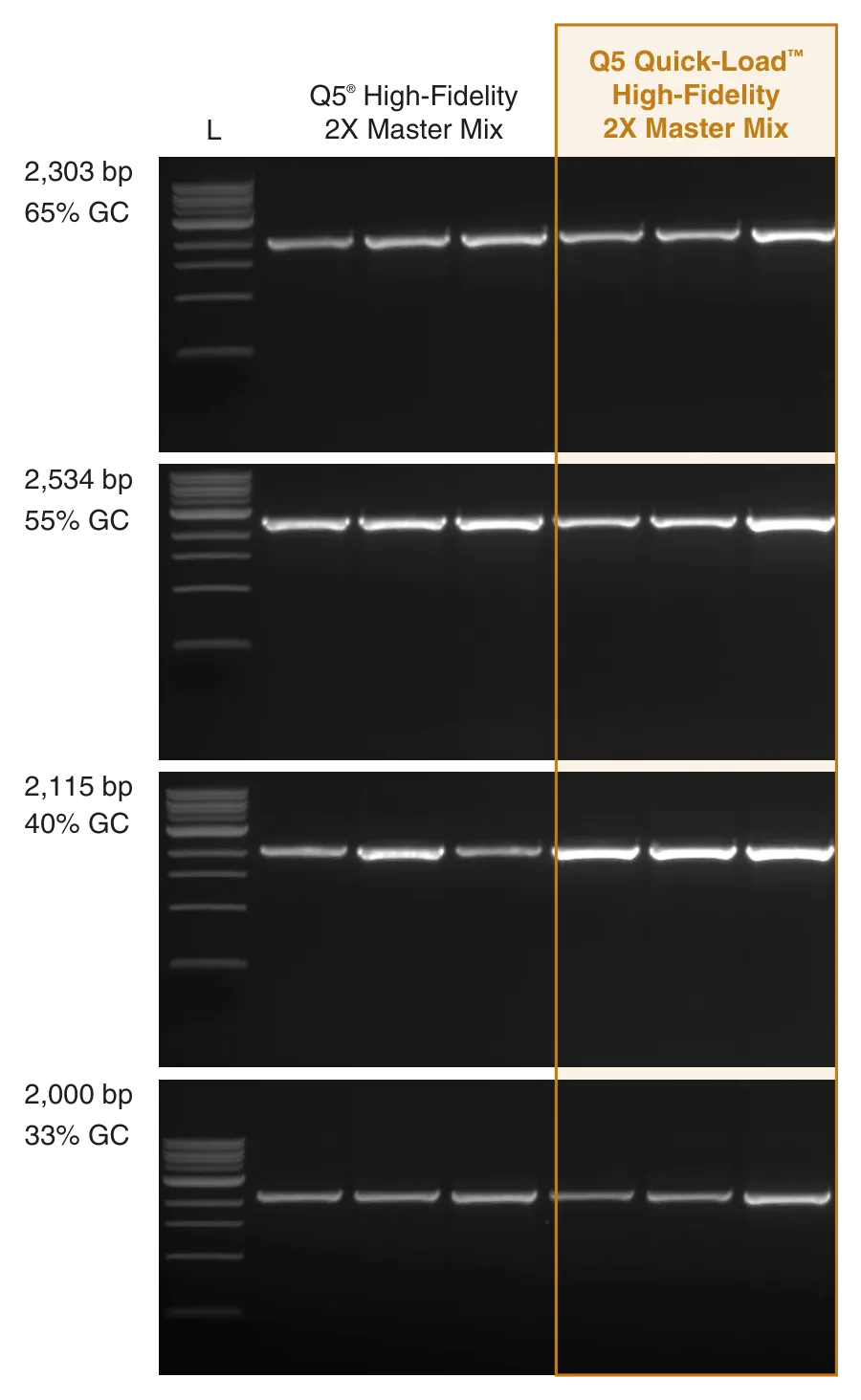Q5 Quick-Load™ High-Fidelity 2X Master Mix
Product information| Code | Name | Size | Quantity | Price | ||||
|---|---|---|---|---|---|---|---|---|
M0578L |
Q5 Quick-Load High-Fidelity 2X Master Mix |
500 rxns (10x1.25ml) |
|
€ 767.00 |
+
|
Q5 Quick-Load™ High-Fidelity 2X Master Mix
Catalog #M0578
Product Introduction
- High fidelity amplification in a convenient format
- Master mix includes Q5® High-Fidelity DNA Polymerase, dNTPs, and Mg++ in a broad-use buffer
- Superior performance for a wide range of amplicons (from high AT to high GC)
- Includes inert tracking dyes for easy and direct loading of PCR products onto gels
- Also available: Q5 standalone polymerase (NEB #M0491, NEB #M0493) and colorless master mix formats (NEB #M0492, NEB #M0494)
- Product Information
- Protocols, Manuals & Usage
- FAQs & Troubleshooting
- Citations & Technical Literature
- Quality, Safety & Legal
- Other Products You May Be Interested In
Product Information
Description
![[Duck photo] Learn more about the Q5® DNA Polymerase family of products](https://media.neb.com/asset/eebadfa7-45f3-419d-9c75-5c05a26bb921/Webp_JPG_PSD/Q5_LearnMore_Banner.webp?=)
The Q5 Quick-Load High-Fidelity 2X Master Mix offers high-fidelity performance in a convenient master mix format. The master mix features Q5, a high-fidelity, thermostable DNA polymerase with 3´to 5´ exonuclease activity fused to a processivity-enhancing Sso7d domain. With an error rate ~280-fold lower than that of Taq DNA Polymerase, Q5 offers highly accurate amplification and can be used to amplify difficult or long targets (up to 20 kb for simple templates). The master mix includes polymerase, dNTPs, Mg++, and two commonly used tracking dyes for easy and direct loading of PCR products onto gels. On a 1% agarose gel in 1X TBE, Xylene Cyanol FF migrates at ~3-5 kb and Tartrazine migrates at ~50 bp. The broad-use buffer requires only the addition of primers and DNA template for robust amplification, regardless of GC content.
To determine the optimal annealing temperature for a given set of primers, use of the NEB Tm Calculator is highly recommended.





![[Icon] Use our Tm Calculator to determine your primers' optimal annealing temperature.](https://media.neb.com/asset/46e6c17d-deda-4972-a20c-2c3463d03d8b/Webp_JPG_PSD/TmCalculator_Banner.webp?=)
- This product is related to the following categories:
- Q5® High-Fidelity DNA Polymerases,
- Master Mixes,
- PCR, qPCR & Amplification Technologies,
- This product can be used in the following applications:
- High-Fidelity PCR,
- DNA Amplification, PCR & qPCR,
- PCR
Properties & Usage
Materials Required but not Supplied
- Thermocycler
- PCR tubes
Related Products
Materials Sold Separately
Protocols, Manuals & Usage
Protocols
Application Notes
FAQs & Troubleshooting
FAQs
- What are the advantages of using Q5® High-Fidelity DNA Polymerase?
- What are the differences between the numerous Q5® Polymerase products available?
- My results are not as expected. Where can I find troubleshooting help?
- What ends will my PCR products have?
- What does exonuclease activity mean for a DNA polymerase?
- What are the properties of this polymerase (fidelity, product ends, max amplicon, modified base incorporation, etc.)?
- Does Q5® High-Fidelity DNA Polymerase exhibit a strand displacement activity?
- How should I determine the appropriate annealing temperature for my reaction?
- What should the final primer concentration be in my PCR?
- When and how should I use the Q5® High GC Enhancer?
- There is a precipitate in the bottom of the buffer tube. Is this normal?
- What is the advantage of using Q5 Quick-Load™?
- What dyes are present in Q5 Quick-Load™?
- Do the tracking dyes present in Q5 Quick-Load™ interfere with downstream applications?
Citations & Technical Literature
Citations
Quality, Safety & Legal
Quality Assurance Statement
Quality Control tests are performed on each new lot of NEB product to meet the specifications designated for it. Specifications and individual lot data from the tests that are performed for this particular product can be found and downloaded on the Product Specification Sheet, Certificate of Analysis, data card or product manual. Further information regarding NEB product quality can be found here.Specifications
The Specification sheet is a document that includes the storage temperature, shelf life and the specifications designated for the product. The following file naming structure is used to name these document files: [Product Number]_[Size]_[Version]Legal and Disclaimers
Products and content are covered by one or more patents, trademarks and/or copyrights owned or controlled by New England Biolabs, Inc (NEB). The use of trademark symbols does not necessarily indicate that the name is trademarked in the country where it is being read; it indicates where the content was originally developed. The use of this product may require the buyer to obtain additional third-party intellectual property rights for certain applications. For more information, please email busdev@neb.com.This product is intended for research purposes only. This product is not intended to be used for therapeutic or diagnostic purposes in humans or animals.
New England Biolabs (NEB) is committed to practicing ethical science – we believe it is our job as researchers to ask the important questions that when answered will help preserve our quality of life and the world that we live in. However, this research should always be done in safe and ethical manner. Learn more.
The supporting documents available for this product can be downloaded below.




